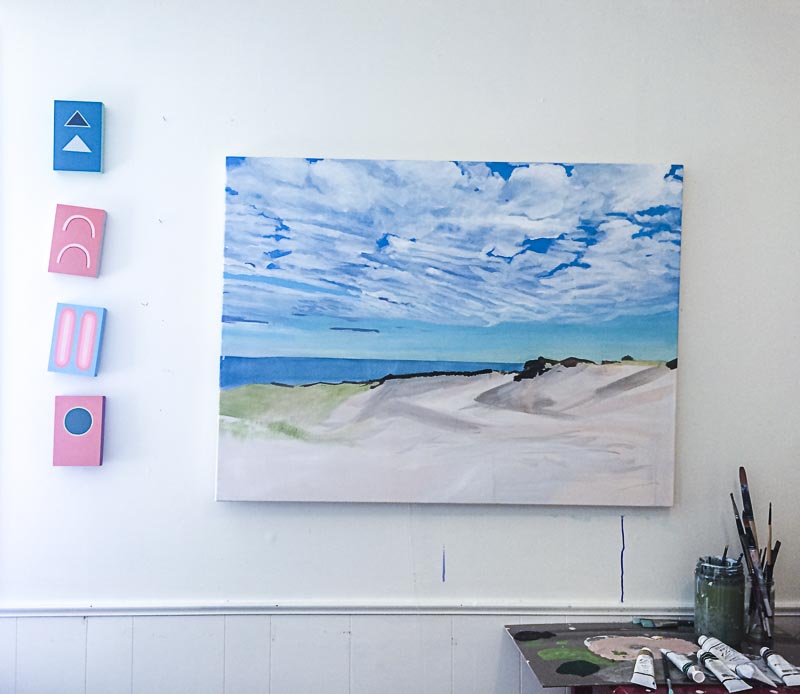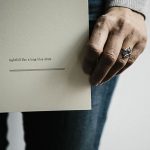BY HOLLY WREN SPAULDING
MADE: A series of conversations with artists about how they navigate impasses and discover breakthroughs in their work.
Read the rest of the series here.
Since meeting her seven years ago, I’ve admired painter Amanda Acker’s ability to tell a story through a single image, as well as her sensitive use of color, which has the effect of teaching me how to see the vibrancy in my own surroundings. How beautiful even the most humble visual details become when I pay attention to the pattern of light on a face, or the folds in a quilt, or to the many greens in a patch of meadow. Of course, tuning one’s eyes to such things is a primary benefit of spending time with art.
Amanda is probably best known for her figurative work, in which her subjects usually appear in domestic and natural settings, embodying the qualities of solitude, introspection, and imagination.
More recently, Amanda has begun painting the wild, watery landscapes along Lake Michigan’s northern coast, near where she lives, but I wanted to talk with her about what she does when she’s not necessarily working on an exhibition or specific project. What kinds of secret or invisible processes are happening in the privacy of her studio?
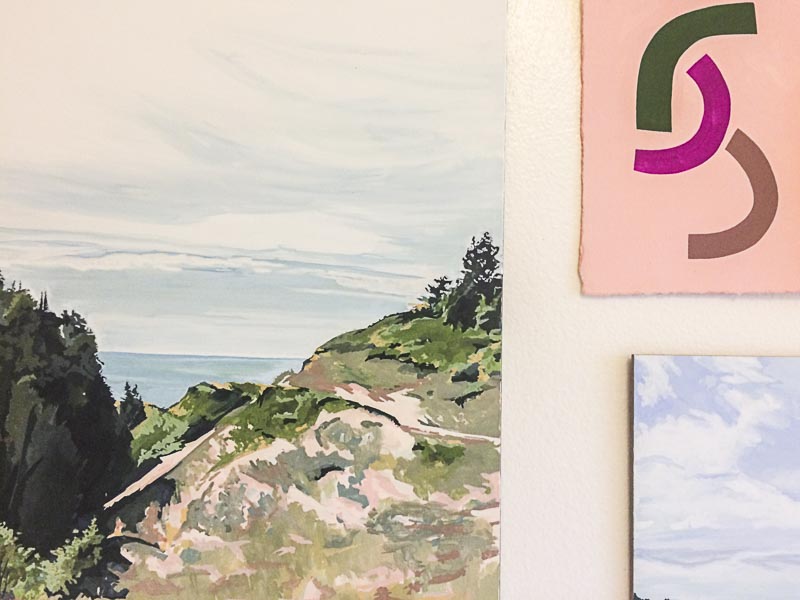
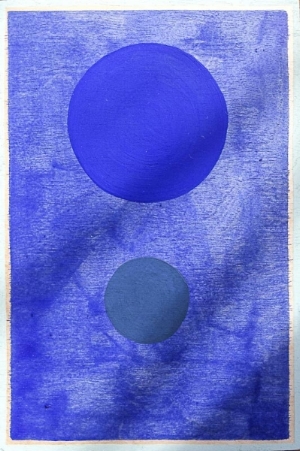
It turns out that a year or so ago Amanda made a conscious decision to take a break from making public work in order to push pure exploration instead. She wanted to forget about audience and turn off self-judgment and find more freedom in her painting practice.
She showed me a collection of small experimental abstracts, none of them larger than the cover of a book. “I don’t even think of them as paintings,” she said, “because they are done for different reasons, outside of what I’d consider my ‘body’ of work. In my mind they’re a whole different animal.”
Pressed to say more, she speculates they may have something to do with “jumbled thoughts, wishes, and ideas being translated into tiny, simple shapes that I can ‘let go.’”
Every artist has to find her way to new work, and while it’s often through experimentation, just as often, she must go through doubt and difficulty. “Last winter I was in the dark cloud of worldly struggles, and letting it shrink the importance of making art about my simple, rural life. I was angry, sad, heartbroken, helpless, hopeless about the world—and the refugee crisis in particular—and it felt like I needed to switch directions in my art. To make art about the struggle. I spent some time—too much time—looking at pictures of crying mothers, drowning babies, bloody faces. I wanted to make pictures that could stick a knife in your heart, but when it came time to make them I felt strangely empty. I couldn’t finish a single piece. I was frustrated. I felt slightly dirty. I heard a phrase, ‘aestheticizing horror,’ and that summed it up. I stopped.”
In her search for a palette cleanser following this dark period, Amanda returned to looking at anonymous Tantra paintings, which she’d long admired for their “egolessness” and simple beauty. The French poet and collector, Franck André Jamme, describes them as “Painted silences. Nothing extraneous. Not the slightest impression of effort. Just certain discreet but sure perfection.”
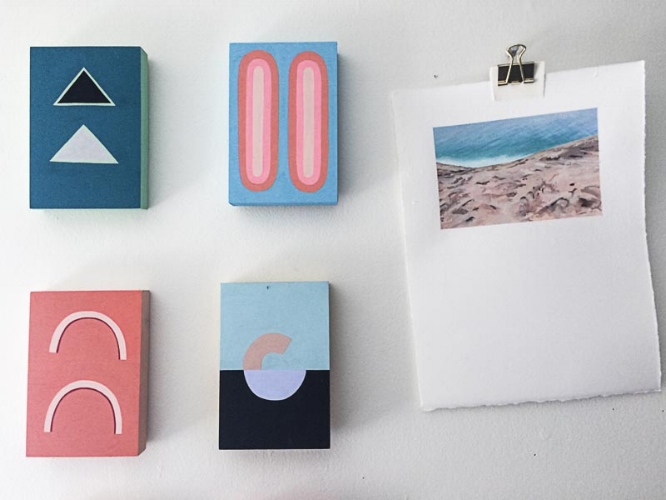
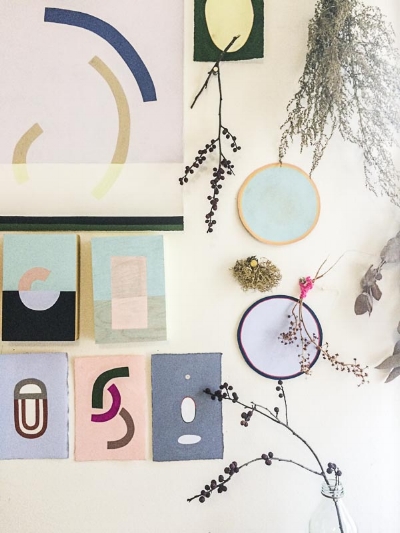
Amanda now knew what to do next. “The only guidelines I gave myself initially were to do them in less than a half hour (to prevent nitpicking), to only use one layer of paint (to prevent overthinking), and to empty my mind the best I could of all preconceived ideas.”
The resulting works are simple, yes, but also weirdly haunting. Even in their flatness and abstraction, they carry an emotional charge. It’s hard not to look at the resulting shape paintings, as she now calls them, and not want to pick up a paintbrush and try exactly what she has just described.
“Veering off course for a bit and feeling those feelings of playfulness, inspiration, exploration, and openness brought a different posture to my ‘regular’ art when I returned. A certain letting go. Things didn’t have to be so defined.”
Amanda is also a mother, and has had to navigate the internal pressure to make smart use of her limited studio time, and this new mode of working has sometimes felt wasteful to her. “In my gut,” she says, “I know it is essential.”
She adds, “There’s much to be said about adding a meditative practice to your days, and even if the practice only happens for a short amount a time, it does something to your mind. I don’t know precisely . . . it slows it down? Brings clarity? Sheds worry/fear/doubt? It creates a general ‘loosening.’ I’ve felt a great sense of freedom in making work that doesn’t have a predetermined destination, like a show, and that isn’t about anything in particular, that doesn’t require a discerning eye or critical contemplation. When my mind tried to make it about something, I say, Fine, let it be prayer. Let it be love. I try very hard to come to the table without expectations.”
Reflecting on a year of doing shape paintings, Amanda can see clear benefits, maybe especially as world events continue to trouble her. “All that energy of fear and hopelessness that was coming with worldly happenings (and personal happenings), made me realize I can think that stuff—I can mourn, feel heartbroken, feel angry, feel joy, feel reverence, feel bored, feel whatever, and I can paint while feeling these things—and I can channel it into something beautiful or at least something striving for beauty. And by doing that it doesn’t mean that I’m ignoring the problems, it means that I’m striving for beauty despite these things, acknowledging beauty, giving time to beauty . . . and maybe that’s my revolutionary act. I do think we all need to have a voice and stand up to the major injustices going on, and I feel I am on my path to finding that clear voice.”
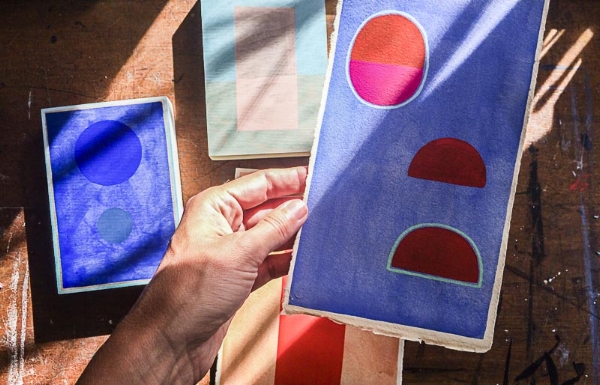
Holly Wren Spaulding is an interdisciplinary artist, teacher, and author, most recently, of Familiars: Poems(Alice Greene & Co., 2020). Holly is the founder and director of Poetry Forge, where she works with emerging writers to develop new work and complete books.

